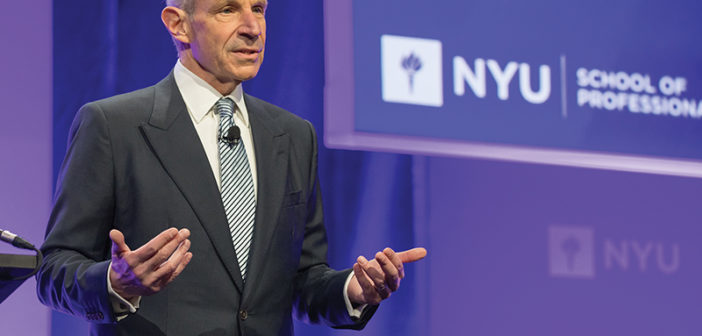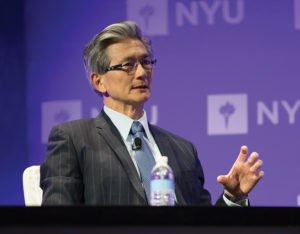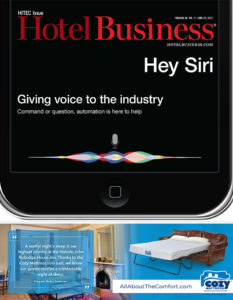NEW YORK—With another 12 months under their belts without a hiccup since the last New York University International Hospitality Industry Investment Conference, some 2,400 attendees gathered here at the Marriott Marquis for the 39th annual event were all about just doing what they’ve been doing thus far that’s worked so well for them.
Whether the CEOs center stage on a panel or a first-timer listening intently, no one appeared “panicky” about the forecast increase in supply, slowing RevPAR growth, more brand introductions or that the head of the world’s largest OTA was in the house.
What was causing concern, particularly for Loews Hotels & Co. Chairman/CEO Jonathan Tisch, were the broadsides being lobbed at travel and tourism, specifically from Washington. Now in his 23rd year as the NYU conference chair, Tisch in his opening remarks called upon the movers and shakers in the audience to unite to prevent policymakers from negatively impacting the industry.
He cited executive orders relating to immigration, the so-called “travel ban”; a ban on laptops on flights from the Middle East with possible extension to all travelers flying to the U.S. from Europe; and calls for “extreme vetting” of travelers from U.S. ally countries, including requirements that visitors hand over cellphones and provide access to social media accounts.
“It’s important to balance security measures designed to keep out people who mean us harm…with words and actions assuring legitimate travelers that we welcome them and their business,” said Tisch.
He described the years following the terrorist attacks on Sept. 11, 2001, as a “lost decade” for the U.S. hotel industry.
“That ‘lost decade’ cost our country over 68 million visitors…$606 billion in traveler spending…and 467,000 jobs. Ending this 10-year slump required a united industry effort to push for pro-travel policies,” he said. Those efforts led to The Travel Promotion Act, creation of Brand USA (now eliminated in the Trump administration’s budget proposal), visa reform and upgrading the customs and entry to the U.S. processes.
“With U.S. immigration and security policies in flux, Brand USA is essential to helping travelers understand and navigate these new and changing requirements. The Trump administration shouldn’t be cutting Brand USA… It should be embracing it,” said Tisch, noting erasing Brand USA will increase the federal deficit by $510 million over three years. “Travel drives the U.S. economy. It’s our job to engage the new leadership in Washington to make sure they understand the role we can play in achieving our shared economic goals. If the Trump administration really wants to cut the trade deficit, they’ll need our help.”
Delivering the conference’s traditional kick-off session, a quartet of CEOs checked in to present a “View from the Top,” taking center stage with Betty Liu, anchor at Bloomberg Television, and founder and CEO of Radiate Inc., a media education company formed to educate entrepreneurs with video. The panel consisted of Thomas J. Baltimore Jr., chairman/CEO of Park Hotels & Resorts; Sébastien Bazin, chairman/CEO of AccorHotels; Mark S. Hoplamazian, president/CEO of Hyatt Hotels; and Dara Khosrowshahi, president/CEO of Expedia.
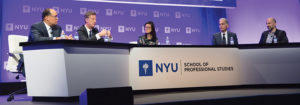
LEFT TO RIGHT: Giving a “View from the Top” on opening day are Thomas J. Baltimore Jr., Park Hotels & Resorts; Sébastien Bazin, AccorHotels; Moderator Betty Liu, Bloomberg Television; Mark S. Hoplamazian, Hyatt Hotels; and Dara Khosrowshahi, Expedia.
The majority of the panel offered an optimistic outlook when asked about the ease of doing business in today’s economic climate. Bazin, the only European on the panel, felt differently, pointing out the complexity of geopolitical events and the growing demand from guests. “It’s not a business for amateurs,” he advised attendees.
Khosrowshahi, who reiterated the importance of the industry coming together to voice its opinion in Washington, pointed out the significant potential of the experience economy, observing people are sharing more and more experiences on social media than ever before.
Bazin called the notion of the industry being cyclical “rubbish,” reasoning OTAs are larger than they’ve ever been. He added when comparing the market to the 1990s, which was snagged by a downturn in the first half of the decade, travel also has become cheaper and more accessible over the years, and that consumers are going for experiences and not just vacation. Bazin also said that when it comes to appeasing and keeping customers, the “retention game is crucial.”
Hoplamazian stressed guests are individuals and, in his opinion, all too often the industry generalizes by grouping guests together, often around what’s trending and guest expectations.
He added the customer wants a seamless journey: e-check-in, e-checkout, noting the business traveler cares about technology in the guestroom, while the leisure customer is looking for interaction, local culture and authenticity.
“Technology innovation may have headline appeal and curb appeal, but it may not necessarily add to the guest experience,” said Hoplamazian.
Similarly, during the Leaders’ Forum, C-Suite executives discussed a variety of topics, including employee appreciation; the use of technology and how it plays a role in hospitality; and the impact of OTAs on the industry.
Led by Adam F. Weissenberg, national managing partner of audit clients and industries and global leader of travel hospitality and leisure at Deloitte, the panel consisted of Eric Danziger, CEO, Trump Hotels; David Kong, president/CEO, Best Western Hotels & Resorts; James J. Murren, chairman/CEO, MGM Resorts; James Riley, group chief executive, Mandarin Oriental Hotel Group; and J. Allen Smith, president/CEO, Four Seasons Hotels and Resorts.
“We do run hotels, but we view ourselves as more of an entertainment company,” said Murren. “And if you view ourselves that way, every decision you make is very intentional around the investments you make… We view entertainment as the driving principle for hospitality, and any way we can reduce the friction to the consumer by making it easier to have that entertainment experience, we’re all in on it.”
Murren pointed out MGM Resorts has three building blocks: customer service and the dynamic between guests and employees, which calls for an investment in the associate, e.g., training, motivation, being the employer of choice, healthcare, wellness, education; the environments themselves—“People come to our places to see something they haven’t seen before,” he said; and leading the charge on entertainment, e.g., music festivals, boxing matches, professional sports, etc.
Smith noted the increasing focus on people and culture and how technology plays a role in enabling guest experience and service quality. “The responsibility around information is really critical,” he said.
Expanding on the topic, Riley said, “One of my key messages to the [Mandarin] team is we don’t need to be a leader in technology. We’ve got to be very alert to the opportunities it provides.” However, he added, the company would avoid overt risk, particularly with a smaller budget than many of the major chains. “What we would be able to use is technology in support of the guest experience through personal empathy and interaction with staff.”
Best Western hasn’t been focusing on apps. Instead, it’s been examining a larger messaging platform.
“What we’re testing right now is to not bother with an app because how many apps do each one of us have on our phones? It’s limited, right?” said Kong. “Let’s say people have 30 apps on their phone, but how many do they actually use? Very few.”
Technology is the same across the board, Kong indicated; however, what’s different is the guest experience. He suggested this is where the industry should focus its efforts. Rethinking the way guests use smartphones is essential to enhancing the customer journey, he added. “We’re testing a whole messaging platform and how we build that communication and build that relationship with guests.” He indicated having a voice-activated device like Alexa in the guestroom would be a boon not only to guests but housekeepers as well.
Smith said at Four Seasons, “The focus on people and culture has never been more important in terms of investing in our people, but I think the other phenomenon we’re all reacting to is how technology plays a role in enabling the guest experience and service quality. That’s the other piece we’re focused on.”
Danziger noted with all the bells and whistles going into hotels today, there are some basics that need to be kept top of mind. “People should focus more on not what size the tile is in the room so much as is it clean? Does it look good? Those kinds of things. The basics of providing a great, comfortable, safe, secure hotel experience,” he said, adding, “Whatever we create needs to be executed flawlessly.”
OTAs and Airbnb made their way into the conversation, with Kong observing: “Whether you like it or not, the OTAs are here to stay,” citing two goals within the hotel/OTA dynamic. “You want people to pick your hotel on their website and you want people to actually shop on their website and then decide to come to your website to make the booking, and all that depends on the success of your brand building.”
Earlier in the conference during an industry association update, Katherine Lugar, president/CEO of the American Hotel & Lodging Association (AHLA), said OTAs, Airbnb and the shared economy are “incredibly important issues in this industry.”
She noted short-term rentals have been “dominating the headlines,” but that AHLA has been making “great progress” in addressing the situation. “This is an issue where we’ve never been focused on folks who want to rent rooms in their homes or occasionally rent their homes; that’s been going on for decades. Where AHLA and a broader group of stakeholders have focused is on the growing arc of inventory on sites like Airbnb that are full-time lodging businesses.” She noted with that model comes obligations. “We increasingly are seeing cities exert their authority to make sure guests are protected, neighborhoods are preserved and taxes are collected in a fair way,” she said.
As to OTAs, Lugar acknowledged, “They remain an important part of our business and an important part of the distribution of hotels. There are really two main areas that AHLA has focused on, and it goes back to transparency for consumers and making sure they know what they’re getting when they book a hotel.”
She added AHLA is working closely with the FTC and House and Senate where bills are moving “to make sure our customers have full disclosure and know who they’re doing business with.”
In the same session, Chip Rogers, president and CEO of the Asian American Hotel Owners Association (AAHOA), said his organization is concentrating on taxation, regulation, energy, infrastructure, healthcare and labor, the latter which he characterized as “absolutely critical.”
He also felt taxation reform “is a real opportunity for us,” noting the last major tax reform was in 1986. “I’d argue that the 1986 tax reform was very good for the U.S. economy in the long run; in the short term what we saw—this is critically important—a year after that was passed commercial real estate values in the U.S. actually fell 14% (there were major changes to the rules that pertained to commercial real estate investments), so we’ve got to have a seat at the table this time around… We’ve got to be careful what happened in 1986 with commercial real estate doesn’t necessarily happen again,” said Rogers. In particular, he cited the threat to the long-standing 1031 (like/kind) exchange, which, he said, “In the last Congress, the Republicans, the Democrats and the president all suggested getting rid of it.”
At the session “Statistically Speaking”, Amanda Hite, president/CEO of STR reported that as of April, the U.S. lodging industry was still at record-setting levels—revenue in 2016 was over $199 billion—although growth rates are slowing, demand is growing and group business is stagnant. ADR is growing only at inflationary levels and supply growth is continuing in the upper-midscale and upscale segments.
In April, demand growth (1.9%) was still outpacing room supply growth (1.7%). Occupancy ticked up only slightly (0.2%) to 65.5% while ADR showed a 2.9% gain to $125, resulting in a 3.1% gain in RevPAR at $82.
“The 1.9% demand growth doesn’t make us super excited, but it is still record demand. And in a period of uncertainty like we’re in today, when you can’t get super excited about incredible growth numbers, you have to remember we’re selling more rooms than we ever have before. For the month of April, we set another record. We sold over 103 million room nights and that’s more than any other April since we’ve been tracking data since 1989,” said Hite. She noted by year’s end, supply growth would outpace demand growth.
In its outlook for 2017 and 2018, STR forecast mostly slight improvements in fundamentals over last year, a scenario expected to replay next year. Data shows supply at a 2% gain this year, ticking up to 2.2% in 2018. Demand comes in this year at 1.7%, up slightly to 2% next year. Occupancy shows a decrease (-0.3%) in 2017, improving only slightly (-0.2%) in 2018. ADR is forecast at 2.5% this year, advancing by 2.7% next year. RevPAR in 2017 is expected at 2.2%, growing in 2018 by 2.5%.
“We’ve had 86 months of RevPAR gain. It’s been very erratic if you look at just the monthly numbers. But the trend has been that RevPAR growth rates are slowing,” said Hite.
She added ADR is only growing at an inflationary level and “our RevPAR growth will come from ADR growth for the next two years at least.”
Looking specifically at markets, the top five highest in ADR (YTD 4/2017) are Miami Beach, FL, $291.24; Naples, FL, $272.28; Washington, DC, $255.83; San Francisco, $250.78; and Scottsdale, AZ, $244.79. The top five lowest in ADR are Laughlin, NV, $70.54; Amarillo, TX, $73.83; Tulsa, OK, $79.07; Albuquerque, NM, $79.29; and Bakersfield, CA, $80.23.
Cities with the highest occupancy (YTD 4/2017) are Lake Buena Vista, FL, 86.7%; Fort Lauderdale, FL, 85.1%; Honolulu-Oahu, 84.9%; Orlando, FL, 83.1%; and Los Angeles, 82.1%. Cities with the lowest occupancy are Branson, MO, 38.4%; Williamsburg, VA, 39.9%; Ocean City, MD, 43.6%; Atlantic City, NJ, 45.6%; and Pigeon Forge, TN, 46.7%.
According to Hite, new construction is continuing in 2017, outpacing 2016’s growth with 189,000 hotel rooms under construction, an 18% gain over last year’s 161,000 rooms; 209,000 rooms in final planning, a 23% increase over 171,000 rooms last year; and 181,000 in planning, a slight increase (4%) over 174 rooms in 2016. There are 580,000 hotel rooms under contract, a 15% gain over last year’s 506,000 rooms.
“The number of rooms under construction, we still haven’t reached our prior peak. That was in December 2007; we had 211,000 rooms under construction. We’re about 22,000 less than that today,” said Hite. “In March and April we actually saw two months of sequential decline in the number of rooms under construction. I don’t know if that’s a trend yet.”
She added the rooms being built are still mostly in the upper-midscale and midscale segments, with 65% of the rooms under construction in those two chain-scale categories.
Meanwhile, Stephen Rushmore Jr., president/CEO of HVS, spoke on hotel values across the U.S.
“If you’re investing in the hospitality industry right now and you’re looking to get value appreciation from the market, you are going to need to be patient,” said Rushmore, noting players will probably have to wait eight to 10 years “before the market is going to give you any sort of meaningful value appreciation for your asset in large part throughout the United States.”
The CEO said in many U.S. markets HVS is forecasting values “to be stable, at least through 2019.”
Rushmore noted a number of forces currently impact value, citing governmental forces as the biggest.
“Governmental forces can impact corporate taxation, interest rates, policies that impact construction costs. We have no idea what impact the current administration is going to have. It can really send values in other directions,” said Rushmore.
Another force is supply. “There’s been a lot of talk and concern about incoming supply in the market. The good news is it’s not going to be disruptive in large part in many markets throughout the United States,” he said.
The CEO did not see new supply as a significant risk in most markets because it is being absorbed. Adding to that, construction financing is becoming “increasingly difficult”; and entrepreneurial incentives have been declining “by about 100 basis points each year for the past several years, making it less attractive to build,” he indicated. Plus, cap rates, which have been stable, are expected to increase “a little bit.” Equity yields, also stable, are expected to drop “a tiny amount” over the next several years, according to Rushmore.
Lenders also are underwriting “a little bit more conservatively,” he said, adding, “Financing conditions are actually quite good right now. For a high-quality, select-service asset, you’re looking at interest rates of about 5%, loan-to-rate value ratios around 8%
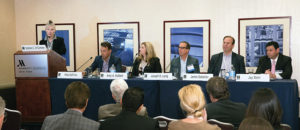
Hotel Business Executive News Editor Stefani C. O’Connor fields a question while moderating a session on boutique and lifestyle hotels. Panelists (left to right) included Mike DeFrino, Kimpton Hotels & Restaurants; Amy A. Hulbert, Best Western Hotels & Resorts; Joe Long, KHP Capital Partners; Jamie Sabatier, Two Roads Hospitality; and Jay Stein, Dream Hotel Group.
This year’s NYU Conference also saw its share of new brand launches, including debuts from Trump Hotels and Wyndham Worldwide.
Trump Hotels revealed plans for a new midscale brand dubbed American Idea Hotels during a cocktail party at Trump Tower.
CEO Eric Danziger pulled back the curtain on the brand concept, noting it’s a departure from the company’s four- and five-star properties, one that would provide budget-friendly, three-star hotel rooms in small towns.
The properties will aim to reflect small-town values and honor the local heritage, noted Danziger, adding there are three signed agreements for American Idea properties in the Mississippi Delta area.
“It is about hometown America,” said Danziger. “We look at it as almost flea market-chic. It means in any given city there’s history, there’s things you can do… You can get a fire truck that was part of that city’s history or if it was a hangar factory town, use the hangars in the hotel to share the concept with the community and the people who live there…and that’s what we’re doing. It’s not Trump, it’s not Scion, it is unique.”
Wyndham Hotel Group has launched a new independent concept for upper-midscale-and-above hoteliers: Trademark Hotel Collection.
Lisa Checchio, VP of brand marketing and insights, said, “Trademark isn’t just another brand: It’s a rally cry for independent entrepreneurs who aren’t afraid to make their own mark. The Trademark Hotel Collection is the next step in our mission to flip the script on existing expectations and champion all hoteliers by offering them an independent choice outside of the current luxury and upscale options available.”
According to the company, the brand’s pipeline includes more than 50 hotels.
The collection is Wyndham Hotel Group’s 19th hotel brand and it’s positioned among the company’s TRYP by Wyndham, Dazzler and Esplendor hotel brands. HB
—CJ Arlotta and Corris Little contributed to this story.
Check out our video interviews at video.hotelbusiness.com

